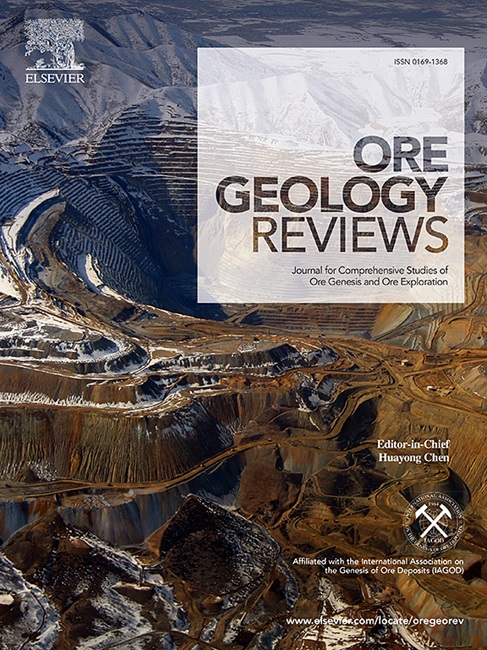Laser ablation inductively coupled plasma tandem mass spectrometry (LA-ICP-MS/MS) Rb-Sr sericite geochronology in orogenic gold deposits: Strategies and significance
IF 3.2
2区 地球科学
Q1 GEOLOGY
引用次数: 0
Abstract
The challenge of determining the age of orogenic gold deposits has long been an issue due to the lack of suitable dating minerals. In recent years, the development of laser ablation inductively coupled plasma tandem mass spectrometry (LA-ICP-MS/MS) has made in-situ Rb-Sr dating of K-rich minerals possible. In gold deposits, K-rich minerals such as sericite are commonly present, providing excellent objects for in-situ Rb-Sr dating. However, since sericite can form during various geological processes, selecting the appropriate sericite to represent the age of gold mineralization is a challenging task. This study focuses on the Liba gold deposit in the West Qinling Orogen, hosted in metamorphosed sedimentary rocks, where sericite is widely developed. The sericite in the mining area is classified into three types based on petrographic and geochemical analysis. Type I hydrothermal sericite is large and euhedral, with the characteristic trace element composition of high B and low Ba, Sr, Sc, and V. Type II interfered sericite exhibits trace element contents that are always intermediate between the other two types. Type III metamorphic sericite is small and euhedral, characterized by low B and high Ba, Sr, Sc, and V. Based on differences in petrography and trace elements, Type I hydrothermal sericite can be identified as the end-member of ore-forming hydrothermal fluids. Type III regionally metamorphosed sericite represents the end-member of metamorphic hydrothermal fluids. Type II interfered sericite is a result of the mixing of these two end-member origins. The in-situ Rb-Sr age obtained from Type I hydrothermal sericite is 208.7 ± 4.3 Ma (n = 25, MSWD = 0.98), interpreted as the mineralization age. The age of Type III regionally metamorphosed sericite is 427 ± 44 Ma (n = 22, MSWD = 3.1), indicating the age of regional metamorphism in the strata. The age from Type II interfered sericite has a relatively large MSWD value, and its age ranges from 187 Ma to 485 Ma, indicating that Type II sericite is affected by a combination of hydrothermal and regional metamorphic processes. Type I hydrothermal sericite has a lower Sr isotope ratio of 0.7091 ± 0.0041, suggesting a crust source. Type III regionally metamorphosed sericite (0.7133 ± 0.0077) exhibit higher Sr isotope ratios, indicating stratigraphic source. From the perspective of Rb and Sr content and Rb/Sr ratio, samples with high Rb/Sr ratio (>100) and low Sr content (<20 ppm) are more suitable for dating. When the span of 87Rb/86Sr and 87Sr/86Sr reaches 10 times and 1.5 times respectively, the dating error can reach less than 3 %. The development and application of LA-ICP-MS/MS Rb-Sr dating technology have addressed the challenges of dating gold deposits, providing new avenues for future geochronological research. This technique holds significant potential for advancements in the field of earth sciences.

造山金矿床中的激光烧蚀电感耦合等离子体串联质谱法(LA-ICP-MS/MS)硼-锶绢云母地质年代学:策略与意义
由于缺乏合适的定年矿物,确定造山带金矿年龄的挑战一直是一个问题。近年来,激光烧蚀电感耦合等离子体串联质谱法(LA-ICP-MS/MS)的发展使富k矿物的原位Rb-Sr测年成为可能。在金矿床中,通常存在绢云母等富钾矿物,为原位Rb-Sr测年提供了很好的对象。然而,由于绢云母可以在各种地质过程中形成,因此选择合适的绢云母来代表金矿化的年龄是一项具有挑战性的任务。本文以西秦岭造山带里坝金矿床为研究对象,该金矿床赋存于变质沉积岩中,绢云母岩广泛发育。通过岩石学和地球化学分析,将矿区绢云母分为三种类型。ⅰ型热液绢云母体积大,呈自面体,微量元素组成特征为高B、低Ba、Sr、Sc、v。ⅱ型干扰绢云母的微量元素含量介于其他两种类型之间。III型变质绢云母体积小,呈自面状,具有低B、高Ba、Sr、Sc、v的特征。根据岩石学特征和微量元素特征的差异,ⅰ型热液绢云母可识别为成矿热液流体的端元。III型区域变质绢云母是变质热液的端元。II型干扰绢云母是这两种端元起源混合的结果。ⅰ型热液绢云母原位Rb-Sr年龄为208.7±4.3 Ma (n = 25, MSWD = 0.98),解释为成矿年龄。III型区域变质绢云母年龄为427±44 Ma (n = 22, MSWD = 3.1),反映了该地层的区域变质年龄。ⅱ型干扰绢云母的MSWD值较大,年龄范围为187ma ~ 485ma,表明ⅱ型绢云母受热液和区域变质作用的综合影响。ⅰ型热液绢云母Sr同位素比值较低,为0.7091±0.0041,为地壳源。III型区域变质绢云母(0.7133±0.0077)Sr同位素比值较高,表明其地层来源。从Rb、Sr含量和Rb/Sr比值来看,高Rb/Sr比值(>100)和低Sr含量(<20 ppm)的样品更适合定年。当87Rb/86Sr和87Sr/86Sr的跨度分别达到10倍和1.5倍时,测年误差可达3%以下。LA-ICP-MS/MS Rb-Sr测年技术的发展和应用解决了金矿测年的挑战,为未来的地质年代学研究提供了新的途径。这项技术在地球科学领域具有巨大的发展潜力。
本文章由计算机程序翻译,如有差异,请以英文原文为准。
求助全文
约1分钟内获得全文
求助全文
来源期刊

Ore Geology Reviews
地学-地质学
CiteScore
6.50
自引率
27.30%
发文量
546
审稿时长
22.9 weeks
期刊介绍:
Ore Geology Reviews aims to familiarize all earth scientists with recent advances in a number of interconnected disciplines related to the study of, and search for, ore deposits. The reviews range from brief to longer contributions, but the journal preferentially publishes manuscripts that fill the niche between the commonly shorter journal articles and the comprehensive book coverages, and thus has a special appeal to many authors and readers.
 求助内容:
求助内容: 应助结果提醒方式:
应助结果提醒方式:


